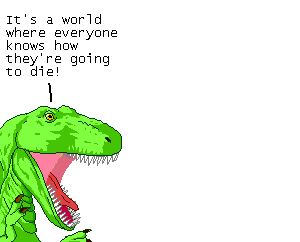
Machine of Death is an upcoming published anthology of short stories edited by Ryan North, Matthew Bennardo, and David Malki !, inspired by this episode of Ryan’s Dinosaur Comics.
All the stories will be about a world where a machine can tell people how they will die.
The machine had been invented a few years ago: a machine that could tell, from just a sample of your blood, how you were going to die. It didn’t give you the date and it didn’t give you specifics. It just spat out a sliver of paper upon which were printed, in careful block letters, the words “DROWNED” or “CANCER” or “OLD AGE” or “CHOKED ON A HANDFUL OF POPCORN”.
At a recent art opening, I pulled exactly such a slip of paper from an art installation by Hank Pine, and the mix of deadly predictions was very similar. A good variety of glamorous or outlandish ways to die (decapitation, dusting accident, lead pipe…), with the occasional realistic downer (I myself got “leukemia”).
Small talk around the death oracle was exactly as described in that call for submissions. “It said ‘lead pipe’… but I don’t know if I’ll be hit with a pipe or poisoned by lead plumbing.”
“OLD AGE”, it had already turned out, could mean either dying of natural causes, or shot by a bedridden man in a botched home invasion. The machine captured that old-world sense of irony in death— you can know how it’s going to happen, but you’ll still be surprised when it does.
I think part of the reason the diseases managed to be shocking was that there were fewer loopholes. “Hey, I… I can’t think of an ironic way to die of AIDS.”
A death oracle might be a good format for my long standing intention to find out, statistically, how I’m likely to die. Filling a hat with 45% “heart attack” would be several levels more morbid, somehow. Not as personalized as the Machine of Death, but just as accurate, in its way. A Pie Chart of Death is within the reach of current technology.
